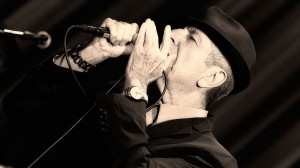
Leonard Cohen sang of an ancient Biblical story in which music was used to heal the sick. wordpress.com/photo
“I’ve heard there was a secret chord
that David played and it pleased the Lord—
but you don’t really care for music, do you?”
Leonard Cohen’s “Hallelujah” recalls one of the most ancient stories of music being used to heal the sick. It is an intentional reference to the Biblical story of David easing King Saul’s disturbed mind by playing music for him on the harp.
In many cultures in ancient times, mental illness was not fully understood. Although there was a basic understanding of madness, many more complicated cases of mental illness were seen as possession by evil spirits. If prayer, exorcism, torture, or imprisonment didn’t help, the mentally ill were often cast out of society and made pariahs, or even put to death.
The medicine of Native American culture had other ways of healing the mentally ill. They used music.
The University of Toronto is taking this idea to a new and innovative level.
Plans are currently underway to create a Music and Health Research Collaboratory at the St. George campus’s Faculty of Music. The new centre would use interdisciplinary methods to focus on music’s healing powers for diseases like Alzheimer’s, Parkinson’s, and fibromyalgia. Other research targets music’s rehabilitative powers in stroke patients.
Currently, similar music centres exist in Cleveland and New York. However, the proposed centre at U of T would stand out for its heavier focus on the medicinal function.
Canada is already facing economic strain as the baby boomer population enters the age of retirement. Worse, the large number of people entering this age have an increased risk of dementia, among other health problems. With costs rising for medication, hospital stays, and palliative care, scientists and therapists hope to take a cheaper approach that uses music.
Music therapy formally began during the two World Wars, when wounded and mentally injured soldiers took comfort in music and dance. By 1950, the National Association for Music Therapy had been born through the collaboration of psychiatrists and music therapists working with war veterans. In 1998, NAMT evolved into what is now called the American Music Therapy Association.
Music creates deep, powerful associations between brain functions. More general music therapy gained increased attention after its success with Gabrielle Giffords, a US politician who was shot in the head last January after an assassination attempt. Music therapists had her sing simple songs, like “Yankee Doodle”, which revived certain parts of her brain associated with word retrieval. As other pathways were opened up by musical memory, she was soon able to move her right arm.
Last November, U of T’s dean of music Dr. Don McLean and associate dean Lee Bartel held information sessions about the proposed plan. The sessions attracted over 200 researchers conducting related research, including using music to decrease Parkinson’s symptoms, induce sleep, alleviate fibromyalgia pain, regain movement after strokes, and increase seniors’ well-being.
Currently, many of these scientists use MRI machines to track the rewiring of neurons taking place when patients, say, sing a familiar song. Research has already found that the human brain processes music in both hemispheres, in areas where language, emotions, motor skills, and memory reside. By activating these neurons through music, scientists and therapists hope to stimulate damaged areas in a less invasive way.
And as University of Western neuroscientist Jessica Grahn noted, with these musical therapies, unlike drugs, “There is essentially no downside.”
